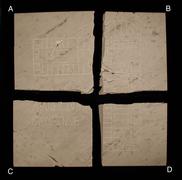






Photographs and text by Natasha Gelfand
Movies courtesy of Sha Sha Chu
June 6, 2001
In order to generate some good fragments on which to test our matching
algorithms, we carved the floorplan of the third floor of the Gates building
on a marble slab measuring 2'x2'x2''. We then broke the slab into fragments
and scanned them to generate our test dataset.
Click here for a description of how we
carved and broke the slab.
In the process of breaking it,
we got a lot of interesting insights into how marble breaks and what
kinds of fragments are generated.
 |
Here are the identifiable pieces we got. There are also about 10 (2-5 cm wide, less than 1 cm thick) sliver pieces that we were not able to fit back. |
 |
The slab assembled back together. The remaining sliver pieces fit into the cracks between the other fragments in the shattered area near the center. They are hard to place because none of them have a top surface. |
 |
To break the slab, we first placed it carved side down onto four wooden supports, one in each corner. We then hit it with a sledgehammer, which made it crack into four chunks (video). We later realized that since the carved side was facing down, the fractures followed the incisions wherever possible, which is why the break is so even. |
 |
We then experimented with different ways to break the four fragments. First, we threw this fragment against the ground, which made the top left corner break into sliver pieces (video). The second time we threw it harder, breaking off the top right corner and completely shattering the bottom left (video). We broke the remaining center piece into two with a sledgehammer (video). |
 |
This fragment was broken by dropping it from a height of about 10 feet (video1, video2). This made it hit the ground a little flatter, which avoided a lot of the chipping. We were able to get a very clean break between the two rightmost pieces by spinning the rock as we dropped it, which made it land completely flat. |
 |
This piece was broken by hitting it with a sledgehammer on the back face. Again, it broke along the incisions wherever possible, since they are the weak points. |
 |
This piece was hit with a sledgehammer on the carved face. The fractures no longer follow the incisions, instead they radiate in a star pattern from the impact point. |